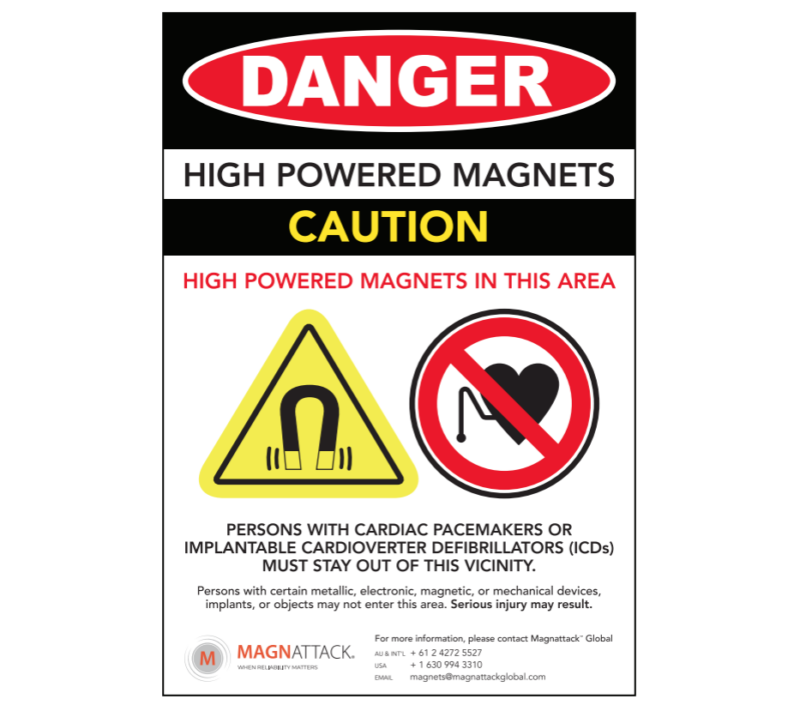Safety in Handling Magnets
Safety is a top priority with Magnattack® magnetic solutions, designed to effectively control metal contamination while protecting your equipment. When handling our magnets, safety is essential due to their powerful magnetic fields. We provide clear guidelines and safety instructions to ensure proper handling and prevent injury, ensuring a safe working environment for all operators.

Disclaimer: This page is provided by Magnattack with no prejudice, and we extend our compliments to you. We remind you that under the Workplace Health & Safety Act & OSHA, it is your responsibility to conduct a risk assessment, review the Standard Operating Procedures (SOP) based on the assessment, modify them as necessary to reflect the actual use of the equipment in your workplace, and ensure proper training for those operating the machine.
The information below is not intended to serve as a comprehensive safety manual, but rather as a set of safety guidelines to assist our valued customers. You must consult the appropriate authorities regarding the correct usage of magnets.
Download the PDF Safety Sheet here.
Watch our safety video to learn how to stay safe around magnets.
Please also refer to Magnattack “Terms and Conditions of Sale,” which is available upon request.
Please note that, in some cases, strong permanent magnets or magnetic assemblies may pose risks or cause injury or damage to persons or property. This warning must be reviewed before operating any permanent magnet or magnetic assembly.
Accidental Injuries Caused by Handling Permanent Magnets
- Magnets can fly together or onto steel objects causing severe pinching or lacerations to the skin.
- Magnets can shatter on impact causing eye injury. Goggles must be used when handling.
- Children must not be permitted to handle or play with magnets.
- Avoid flame or oven heating, grinding, or cutting of magnets. These procedures carry a risk of oxygen absorption and possible shattering. Enclosed magnets if heated may explode.
Other Health Considerations
Long-term daily handling of Permanent Magnets may represent a health risk. These health risks are discussed in British Pre-Standard No. 50166-1. We conclude from this Standard that there is usually no danger to operators occasionally cleaning or handling magnets with static magnetic field levels up to 20,000 gauss or 2 Tesla. A more recent paper INCIRP “Guidelines on limits of exposure to static magnetic fields” can also be referred to on this subject.
As a Simple Precaution, We Recommend the Following Safety Considerations
- Avoid unnecessary handling and uninformed handling/assembly of magnets.
- Avoid long term close bodily contact with strong magnets.
- Keep strong magnets away from head, eyes, heart, and trunk.
- Continuous daily exposure should not exceed 2,000 gauss or 0.2 tesla.
- Maximum one off exposure should not exceed 20,000 gauss or 2 tesla.
- Persons with cardiac pacemakers, hormone infusion pumps (e.g. insulin), or other sensitive devices implanted in the body, or metallic prosthetic implants must not handle or come into close proximity to magnets. Specialist medical opinion must be sought before such persons handle magnets or come into close contact with magnets or magnetic fields.
- Persons with cardiac pacemakers must not allow a magnet within close proximity of their chest or be in an environment above .5mt (5 gauss).
- As a general guide, persons with cardiac pacemakers should avoid coming closer than 12″ or 300 mm from the working or field-throwing face of magnets such as:
- Small plate magnets, grate magnets, probe magnets, magnet bars, spherical magnets, etc.
- Note: there are other magnets such as suspension magnets, magnetic drums and pulleys, overband and crossbelt magnets, etc, which could require the minimum distance to be up to 2 meters. When in doubt, a gauss chart should be undertaken.
- IMPORTANT: NO PERSON WITH A PACEMAKER SHOULD EVER HANDLE OR CLEAN MAGNETS!
Damage to Electronic Equipment
Permanent Magnets can cause damage to electronic equipment such as (but not limited to):
- Phone cards.
- Smart cards.
- Credit cards.
- Computer discs & computer equipment.
- Video, audio and computer tapes.
Close contact can erase stored information. Keep magnets away from electronic equipment (N.B: We can advise on the insulation of vulnerable items).
Lifting or Holding Magnets
The “Lifting Magnet Safety and Training Sheet” must be consulted before carrying out lifting or holding operations with magnets. This is usually supplied upon magnet delivery, but if missing, please contact us to obtain a copy before use.
Transporting of Magnets – Dangerous Goods
- Strong magnets may affect navigation instruments in aircraft.
- If air-freighting magnets, please advise your freight agents and the airline, and consult your Dangerous Goods Management Authority. Magnets should usually be road-freighted and your freight company must be provided with a copy of this “Safety and Handling Magnets” sheet.
- We can advise on or provide special insulation packaging which satisfies transport regulations.